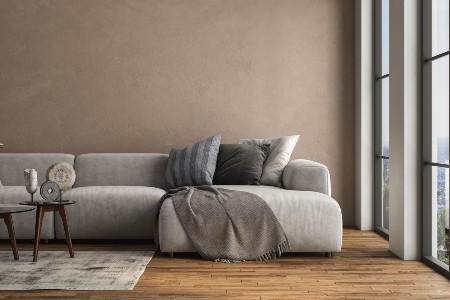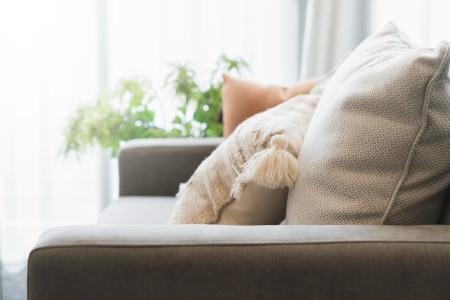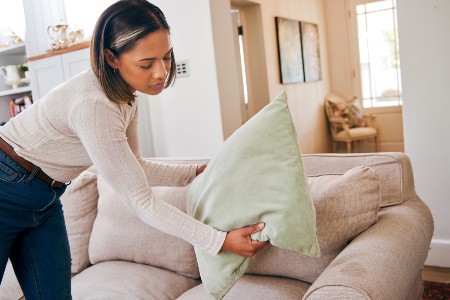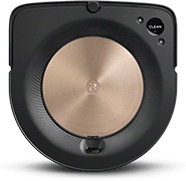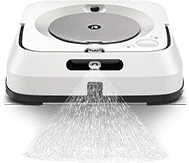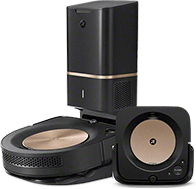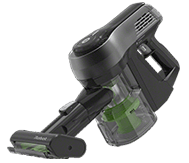How to Clean a Couch, Chairs, and Other Upholstery
Whoever in their right mind decided to make white couches a trend… Okay, we love a gorgeous white couch, but cleaning it? Not so much.
Heck, deep cleaning any couch can be an absolute nightmare if you don’t know what to do, especially if it’s a new couch.
No matter how appealing the advertising is about the couches’ fabric being waterproof, scratch-proof, stainproof, and spill-proof, you still end up with stuff on your couch.
The thought of putting the cushion covers in the wash (even though some couches say you can), or spraying it with an upholstery cleaning solution, or scrubbing out a deep stain probably makes you cringe.
Never fear though, we’ve done the work to find out how to clean a couch, chairs, and other upholstery without damaging the fabric.
How to clean your couch- based on your upholstery
We all know that it’s not just the random cheese puff crumbs from binging The Office (for the 11th time) – i t’s also your dirty feet and socks constantly rubbing at the same spot.
It’s your clothes carrying debris and dirt onto the fabric again and again over months.
It’s the dark spots on the arms from the sweat during the summer and all the times you’ve grabbed the arm to help yourself up.
Yeah, the couch is just generally dirty.
How you clean it absolutely depends on the couch, the color, the fabric, and your couches’ cleaning instructions.
After taking a look at the tags of our own, and the cleaning instructions for about a dozen others online, we’ve discovered a few things:
- Couch manufacturers are a bit more clever these days, understanding that people need an easy way to clean their couches. They’ve made them easily removable and washable in your regular washing machine.
- Some couches are now spill and stain-resistant, and legitimately live up to that (if you haven’t seen a video of someone spilling stuff on a couch and then cleaning it up with a paper towel… you just wait).
- Most couches are made out of fabric that holds up to regular wear (think your butt rubbing against the same spot for years), meaning they’ll also hold up to your scrubbing at a stain for a few minutes. So don’t hold that as a fear when cleaning spills from your couch.
When it comes down to getting rid of those big puddle stains on the couch, we either attack them with cleaning products that are supposed to do the trick, or search for non-damaging tricks.
The problem is, the cleaning method you need to get your couch clean depends a lot on the upholstery (and of course, the mess).
(And… be honest, you’ve never looked at the care instructions. You may have even torn that stuff off because it’s not aesthetically pleasing, or keeps swiping at your backside like a shirt tag on your neck.)
Here’s a breakdown of how to clean your couch based on the most common types of upholstery.
(But please DO look at your particular furniture’s care instructions. Just Google it if the tag is gone.)
Types of upholstery
- Polyester
- Rayon
- Nylon
- Velvet
- Cotton
- Tweed
- Suede
- Microsuede
- Acrylic
- Leather
- Wool
- Olefin
- Canvas
- Microfiber
- Chenille
- Acetate
- Jute
- Linen
- Silk
- Crypton
- Faux Leather
- Sunbrella
First, yikes, that’s a long list of different fabrics. Second, there are probably a lot of fabrics in there that you’ve never heard of– sunbrella, crypton, olefin.
Fabric manufacturers are getting rather clever, blending natural fabrics to create a new one or even using plastic compounds to create durable threads with unique properties (and even blending these synthetic fabrics).
Sunbrella– is a synthetic fabric with UV resistance, originally designed for patio furniture, which means it holds up to fading and harsh weather.
It also means it’s stain, water, and mildew resistant. You’ll find this fabric on a lot of outdoor furniture.
Olefin– is also made from plastic compounds, though often uses recycled plastic. Either way, when used for indoor furniture, the covers are removable and machine washable. For spills you catch immediately, it’s easily washable with a wet rag.
While those two types of fabric are easy to maintain, couches made of velvet or suede… not so much.
So how do you clean the most challenging fabrics– linen, cotton, and velvet?
How to clean a natural fiber couch, chair, or ottoman
Cotton is the most common fabric used on couches. It’s easy to dye, breathable, soft, and abundant even as a natural material.
Luckily, it’s fairly easy to clean. Here’s how:
1. Vacuum your couch (a handheld vacuum cleaner, like our iRobot® H1 Handheld Vacuum is perfect for this) to remove any loose debris and dirt, paying close attention to the crevices. Not doing so could push the dirt into your couch (and we all know what happens to dirt when it gets wet). You can also go over the stained area with a lint roller if you don’t want to break out the vacuum.
2. Fill a spray bottle with cup of warm water and spray the entire couch or the small area of the couch you’re hoping to clean.
3. Add a laundry stain remover to the water bottle. If it has oxi cleaning power, even better. A free and clear without heavy scent is typically better, since the scented detergents are usually full of perfumes (often using a type of wax to really cling to your clothes for an extended time) that can build up in your fabric. Spray your couch, just as you did with the distilled water.
(p.s… if it contains brightener, do not use it or do not let it dry on your fabric, as it may lighten the color)
4. Rub a clean, white rag (or painter’s rag), in gentle circles across your couch. You’ll start to see the dirt coming up and onto the rag. Just switch to different parts of the rag as needed, so you’re not just spreading the dirt.
5. Empty your spray bottle with the water and detergent solution (unless you have a second spray bottle to use), and fill it with sparkling water and a few tablespoons of white vinegar.
6. Spray the couch again. The sparkling water will help to bring up the detergent, while the vinegar will help dissolve any suds and smells.
7. Use another white rag to scrub your couch surface back and forth until you’re no longer getting up any dirt.
(As you can tell, it’s a good idea to have several white rags on hand for this)
Cleaning a microfiber couch (and other synthetic fabric couches)
When microfiber became a fabric option, it became the go-to for most homeowners. It’s ultra-soft, looks luxurious (almost like velvet), and is easy to clean. But it can also look dirty pretty quickly.
Luckily, microfiber couches can stand up to some hefty scrubbing.
Here’s the process for cleaning a microfiber couch:
- Spray the entire couch or section with an oxi-based or solvent-based cleaner. Some of the stains may appear darker at this point. That’s okay. You can now see all the spots you need to scrub.
- With either a soft-bristled brush or a microfiber rag (you can also wrap the bristles in a microfiber brush for extra scrubbing power with protection against the bristles), swipe over your couch. Pay extra attention to the areas with a lot of dinge or stains.
- If there are still dirty spots, spray the surface again and repeat scrubbing until the spot is gone.
- Grab your wet vacuum, and fill the water container with lukewarm water, mild dish detergent, and a small amount of white vinegar. Spray your couch with the mixture and suck up the liquid with your wet vacuum.
- You may see more dirt coming up with the suction. Keep using the wet vacuum until the water you take up is clear.
- You can either let the couch air dry, pat it down with a dry white cloth (lint-free is best), or use a hair dryer on its lowest setting.
If it’s only slightly dingy over the entire surface and you’re just doing a light cleaning, another option is to:
- Wet a microfiber cloth with mild dish soap.
- Wrap the cloth around a pot lid (yes, a pot lid, like one you’d cook with), using a rubber band to secure it around the handle (or just hold it together with your hand).
- Rub the pot lid with the rag over your couch surface in a circular motion.
- Rinse out and rehydrate the rag as needed.
With this light clean, the couch will generally air dry fast on its own. When you pull away the rag, you may see the dirt and grime you’ve lifted from your couch– replace the rag as needed.
How to spot-clean a couch or chair
Once a spill or stain is set into your couch, it’s not so easy to spot-clean it. More than likely, you’ll have to clean the entire section of the couch– on most fabrics.
If you clean just a small spot on your couch, you’ll probably see streaks or water spots afterward that make it look just as dirty as before.
That doesn’t mean you can’t spot clean, though.
You just have to catch the mess right after it happens.
To spot-clean your couch (a safe method for most couches):
- Fill a bowl with lukewarm water and liquid dish soap (you can also add baking soda if it’s a smelly mess)
- Soak a white, clean rag (painter’s rags are perfect for this) in the bowl, and wring out the water, keeping the rag sufficiently damp.
- Dab at the stain with the wet rag until the couch is wet. Do not rub, as this may set the stain further into the fabric. Continue until the stain is gone, wetting the rag more as needed.
- Gently blot the area with a dry white rag, even pressing into the fabric firmly to remove deeper water.
How to remove a stain from a couch or upholstery
While it will depend on the type of fabric you have, most couches can stand up to a fair bit of scrubbing and water.
To remove a set in stain (like the coffee that your SO insists on drinking in a tiny cup while watching the morning news), much of the instructions for a regular cleaning of your couch still apply.
You’ll have to clean the entire section where the stain is (even if the rest isn’t dirty). If not, you’ll likely see a water stain or streaks from scrubbing.
Though on a cotton couch you may get away with spot cleaning if you dry the area fast with a hair dryer.
There are a few methods you can use to get stains out of your couch, no matter what type of upholstery you have:
- Use a wet vacuum with either liquid dish soap, laundry stain remover, or an oxidized or water based cleaner
- Use a stain fighter with a scrubbing brush head (some bottles have a scrubber attached to the cap) specifically designed for your fabric upholstery type
- Pour vodka or rubbing alcohol over the stain, and use a rag to dab until you’ve lifted it. It works like a solvent to dissolve stains. Don’t worry, the smell will fade once it’s dry, but if you’re worried, you can always neutralize it with baking soda. Just make sure to vacuum up the baking soda after use.
- Pour dry cleaning powder on the stain. Use a soft-bristled brush to rub the powder in. Let it sit for up to an hour. Remove with a vacuum (a handheld vacuum cleaner, like our iRobot® H1 Handheld Vacuum is perfect for this).
- Steam cleaning can also be fairly effective for removing stains from most couches.
- For really set-in stains, such as grease stains, consider a professional cleaning.
How to get smells out of your fabric furniture
Baking soda and vinegar. Two natural miracles from the way most of the internet talks about them in every single cleaning video and article.
But there is a great reason why they’re touted so much (even by us).
Most stains and odors consist of acidic compounds. Baking soda is a base. When it collides with the acids, it neutralizes them.
Vinegar is an acetic acid, which also neutralizes and also dissolves acids. You need both to completely eliminate smells from your couch.
Keep in mind though, that baking soda, while powdery, is still grainy. Use it too often and it could damage some fabrics.
You also want to have a way to remove the baking soda from your couch (such as a wet vacuum), as it will build up in the fabric over time or leave a mild residue behind.
For smellier smells, like pet urine, you might want to use something like an enzyme-based cleaner designed to release pet urines from fabrics.
You can even use a pet urine carpet cleaner to attack these stinky stains.
What kind of couch cleaners and tools should I use?
The tools and couch cleaners you use will vary depending on your fabric. A couch made of linen isn’t going to stand up to the same level of scrubbing that one of microfiber will.
A microfiber couch can handle a lot, but it’s also easy to leave scratches or lines in the fabric from scrubbing back and forth.
That said, there are a few upholstery cleaners and cleaning tools that are generally safe for most couches, including:
- A handheld vacuum cleaner, like our iRobot® H1 Handheld Vacuum
- Baking soda
- Vinegar
- Dish detergent
- Laundry detergent
- Laundry stain remover
- Oxi-clean
- Microfiber cloth
For most couches, this is enough to keep your couch clean, sanitary, and looking new.
How to protect your clean couch from stains and grime
Unless you put a plastic sheet over your couch, you’re going to have to clean it once in a while. The air in your home is full of dust, smells wafting from the kitchen, pet dander, and so on. All of it sinks into the fabric of your couch and makes it dirty and smelly over time.
But there is a way to delay cleanings, and keep your couch smelling and looking fresh for longer:
- Coat your couch in a stain-resistant spray- there are upholstery sprays that act as a non-toxic barrier against dirt, dust mites, stains, and spills. When you first get your couch, or right after you clean it, spray it down as a preventative measure.
- Use a sheet, blanket, or pet cover and train your pet to sit only on that spot (or just put the cover in a spot they frequent- most pets generally sit in the same area). This will help to keep dander, urine, pet hair, and other pet matter from embedding into your couch cushions.
- Get a couch cover- instead of just covering a single area for your pet, you can protect your whole couch with a couch cover (especially useful if you have children). There are some fairly attractive couch covers online. Some that keep your couch from looking as though there’s a cover on it at all.
- Vacuum your couch regularly with a handheld vacuum with a brush attachment. This will help to release set-in dirt that will make your couch look dingy over time.
Few people really want to spend the time and energy cleaning their couches. But it’s a massive piece of furniture in most living rooms, making it one of the first things people notice when they visit (or you… you’ve most certainly noticed and you can’t stand it anymore).
With our couch cleaning tips and the right tools, you’ll be able to bring your couch back to its glory days of being new and fresh.
Now get cleaning.




